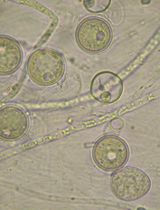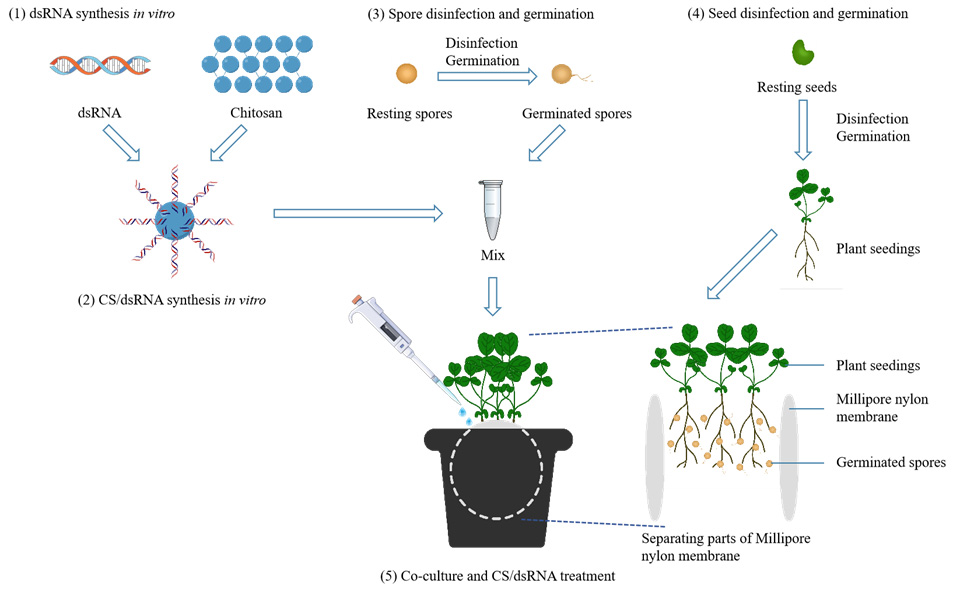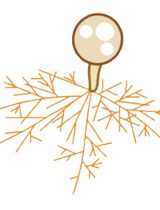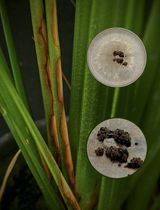- EN - English
- CN - 中文
Silencing Arbuscular Mycorrhizal Fungal Gene Using Chitosan Nanoparticle-Mediated dsRNA Delivery System
利用壳聚糖纳米颗粒介导的dsRNA递送系统沉默丛枝菌根真菌基因
发布: 2025年06月05日第15卷第11期 DOI: 10.21769/BioProtoc.5326 浏览次数: 2410
评审: Shweta PanchalAnonymous reviewer(s)

相关实验方案

微生物提取物对卵菌辣椒疫霉菌和猝倒病疫霉的体外筛选
Mónica Trigal Martínez [...] María Ángeles Vinuesa Navarro
2025年09月20日 1036 阅读
Abstract
It has been discovered that many phytopathogenic fungi can absorb exogenous double-stranded RNAs (dsRNAs) to silence target genes, inhibiting fungal growth and pathogenicity for plant protection. In our recent report, the beneficial arbuscular mycorrhizal (AM) fungi are capable of acquiring external naked dsRNAs; however, whether the dsRNAs can be delivered into AM fungi through nanocarriers remains to be investigated. Here, we introduce a simple and advanced method for in vitro synthesizing chitosan (CS)/dsRNA polyplex nanoparticles (PNs) to silence the target gene in the AM fungus Rhizophagus irregularis. This method is straightforward, requiring minimal modifications, and is both efficient and eco-friendly, offering potential for rapid application in elucidating gene functions in AM fungi.
Key features
• The chitosan can carry the dsRNA derived from the AM fungus Rhizophagus irregularis.
• CS/dsRNA polyplex nanoparticles (PNs) can successfully silence the target gene in the AM fungus R. irregularis.
• CS/dsRNA PNs can be applied to the characterization of AM fungal genes via the spray-induced gene silencing (SIGS) approach.
• This protocol can be applied in asymbiotic and symbiotic cultures of AM fungi.
Keywords: Arbuscular mycorrhizal fungi (丛枝菌根真菌)Graphical overview

Overview of the chitosan/dsRNA gene silencing procedures
Background
Arbuscular mycorrhizal (AM) fungi are widely distributed in terrestrial ecosystems and can form symbiotic associations with 72% of land plants [1–3]. However, AM fungi are obligate symbionts that are not capable of completing their natural life cycle without the host plants [4]. Therefore, it is very difficult to characterize AM fungal gene functions by mutation methods such as gene knockout. RNA interference–based methods, such as HIGS (host-induced gene silencing) and VIGS (virus-induced gene silencing), can provide alternative tools for AM fungal gene knockdown during AM symbiosis [5–8]. Despite their potential, these host plant–dependent cross-kingdom RNAi methods have their limitations: HIGS is hindered by the host plant's transformation efficiency, while VIGS faces constraints due to the transient nature of gene silencing. Moreover, HIGS and VIGS approaches are not suitable for elucidating gene functions in AM fungi during the asymbiotic and presymbiotic stages.
In recent studies, some phytopathogenic fungi have been found to have a robust capacity to absorb exogenous double-stranded RNAs (dsRNAs) and small RNAs (sRNAs), which can silence target genes in fungi via the RNAi pathway, thereby reducing fungal growth, development, and pathogenicity [9–11]. The spray-induced gene silencing (SIGS) is an innovative and eco-friendly technology where application of gene-targeting dsRNAs to fungal materials can enable gene functional analysis in AM fungi [12]. However, SIGS applications remain limited because of the instability of RNA, which can be easily degraded when exposed to various environmental conditions. Also, continuous application of dsRNAs is required to maintain the RNAi effect [13–14]. Qiao et al. [15] described the use of artificial nanovesicles for dsRNA delivery in SIGS for crop protection. The results of this work inspired how nanocarriers can be used as new carriers to overcome RNA instability in SIGS for AM fungal gene analysis.
Chitosan (CS) is a natural polysaccharide derived from marine organisms with excellent biocompatibility and biodegradability [16]. The interaction between the positively charged amino groups in chitosan molecules can form stable complexes with the negatively charged phosphate groups in RNA chains. Therefore, chitosan may be an ideal delivery carrier for dsRNAs, sRNAs, and other molecules [11,16,17]. Importantly, the use of nanoparticles as a carrier for dsRNA not only protects dsRNAs and slows down their degradation rate but also effectively delivers dsRNAs into the cells of living organisms to achieve precise gene silencing.
Here, we synthesize chitosan/dsRNA polyplex nanoparticles (PNs) that target the RiABCG6.3 gene (Gene ID: XM_025322239.1) in Rhizophagus irregularis. RiABCG6.3 is a homolog of the known ABCG-1 gene, MoCDR1, in rice-blast fungus Magnaporthe oryzae, which facilitates appressorium formation [18]. We can speculate the role of RiABCG6.3 in appressorium or hyphopodium formation in R. irregularis and use chitosan/dsRNA PNs to silence the transcripts of RiABCG6.3 to explore its function at the early stages of AM symbiosis. By introducing this chitosan/dsRNA PNs complex to R. irregularis and mycorrhizal roots of Astragalus sinicus seedlings, the expression of RiABCG6.3 is successfully silenced. This approach is straightforward, requiring minimal modifications, and is both efficient and eco-friendly. Overall, the applications of chitosan/dsRNA PNs to fungal materials can elucidate gene functions in AM fungi.
In this protocol, we outline the detailed procedures for the in vitro synthesis and characterization of chitosan/dsRNA PNs (Graphical overview) and assessment of the efficiency of gene silencing via RT-qPCR assay.
Materials and reagents
Biological materials
1. AM fungal spores [Rhizophagus irregularis DAOM 197198 spores’ solutions with 10 mM sodium citrate buffer (pH 6.0) were kindly provided by Dr. Nianwu Tang, Guangxi Institute of Botany, Guilin, China].
2. Astragalus sinicus seeds (obtained from the National Key Laboratory of Agricultural Microbiology at Huazhong Agricultural University, Wuhan, China)
Reagents
1. Nuclease-free water (Sigma-Aldrich, catalog number: 3098)
2. Chitosan (Sigma-Aldrich, catalog number: C3646)
3. Na2SO4 (Sigma-Aldrich, catalog number: 239313)
4. Acetic acid (Sigma-Aldrich, catalog number: A6283)
5. Sodium acetate (Sigma-Aldrich, catalog number: 229873)
6. Micrococcal nuclease enzyme (NEB, catalog number: M0247S)
7. SDS (Sigma-Aldrich, catalog number: 75746)
8. Fluorescein-12-UTP (Sigma-Aldrich, catalog number: 11427857910)
9. Gel Recovery kit (OMEGA Bio-Tek, catalog number: D2500)
10. HiScribe® T7 High Yield RNA Synthesis kit (NEB, catalog number: E2040L)
11. RNase-free DNase I (Sigma-Aldrich, catalog number: 69182)
12. GR24 (Strigolactone analog) (Macklin, catalog number: S885104)
13. Chloramine T (Sigma-Aldrich, catalog number: 402869)
14. Streptomycin (Sigma-Aldrich, catalog number: 85886)
15. Gentamycin (Sigma-Aldrich, catalog number: 345814)
16. Agarose (Sigma-Aldrich, catalog number: A9539)
17. WGA488 (Alexa Fluor 488 labeled wheat germ agglutinin) (Thermo Fisher Scientific, catalog number: W849)
18. DNA marker (Takara, catalog number: 3427Q)
19. RNA marker (Takara, catalog number: TCH023)
20. 10× DNA loading buffer (Vazyme, catalog number: P022-01)
21. RNA loading buffer (Sangon, catalog number: B548317)
22. NaAc (Sigma-Aldrich, catalog number: S7670)
Solutions
1. Sodium acetate buffer, pH 4.5 (see Recipes)
2. 2.5 mol/L Na2SO4 (see Recipes)
3. 0.02% chitosan working solution (see Recipes)
Recipes
1. Sodium acetate buffer, pH 4.5
| Reagent | Final concentration | Quantity or Volume |
|---|---|---|
| NaAc | 0.1 M | 18 g |
| Acetic acid | 0.1 M | 9.8 mL |
| Nuclease-free water | n/a | up to 1,000 mL |
| Total (optional) | n/a | 1,000 mL |
2. 2.5 mol/L Na2SO4
| Reagent | Final concentration | Quantity or Volume |
|---|---|---|
| Na2SO4 | 2.5 M | 17.755 g |
| Nuclease-free water | n/a | up to 50 mL |
| Total (optional) | n/a | 50 mL |
3. 0.02% chitosan working solution
| Reagent | Final concentration | Quantity or Volume |
|---|---|---|
| Chitosan | 0.02% | 0.02 g |
| Nuclease-free water | n/a | up to 100 mL |
| Total (optional) | n/a | 100 mL |
Laboratory supplies
1. Millipore nylon filter membrane (JINTENG, catalog number: LG05-112)
2. Quartz sand (Macklin, catalog number: S861671)
3. Nuclease-free centrifuge tubes (Sangon Biotech, catalog number: F601621-0010; F607620-0005)
4. Pipette tips (Vazyme, catalog number: PTB00122, PTB02022, PTB10022)
5. Microscope slides (Sangon, catalog number: F518111-0001) and coverslips (Sangon, catalog number: F518117-0001)
6. Plastic pots (6 × 6 cm diameter) (Hongyue, catalog number: 26541)
7. Sterile Petri dishes (90 mm diameter) (Huankai, catalog number: 88574540)
8. Fine tip tweezers (Sangon, catalog number: F519231)
9. Spray bottles (Hongyue, catalog number: 30700)
10. Personal cell phone (in our case, iPhone 13)
Equipment
1. Thermal cycler CFX96 touch real-time PCR detection system (Bio-Rad, CFX ConnectTM, catalog number: 1855200)
2. Thermal cycler PCR (Bio-Rad, catalog number: S1000)
3. Analytical balance (Mettler Toledo, model: Tle204/02)
4. Vortex mixer (Thermo Fisher Scientific, catalog number: 88882012)
5. pH meter (METTLER TOLEDO, catalog number: 30254104)
6. Gel image analysis system (Bio-Rad, model: T2A)
7. Electrophoresis power supply (Liuyi Biotechnology, model: DYY-)
8. Electrophoresis chamber (Liuyi Biotechnology, catalog number: 122-3146)
9. Confocal microscope (Zeiss, model: LSM 710)
10. Sceintz-48 high-throughput tissue grinder (Sceintz, model: 18-G009)
11. Fluorescence microscope (Nikon, catalog number: Y-TV55)
12. Stereo fluorescence microscope (Nikon, catalog number: SMZ18)
13. Nucleic acid protein analyzer NanoDrop 2000 (Thermo Fisher Scientific, catalog number: ND-2000)
14. Plant growth chamber
15. Thermostatic water bath (OLT, catalog number: HH-24)
Software and datasets
1. BLASTn and BLASTp (http://blast.ncbi.nlm.nih.gov/Blast.cgi)
2. Mega11.0 (https://www.megasoftware.net/dload_win_beta)
3. siRNA-Finder (si-Fi) software [19] (https://github.com/snowformatics/siFi21-)
4. GraphPad Prism v9.0.0 (https://www.graphpad.com/scientific-software/prism/)
5. Integrated DNA Technologies (https://sg.idtdna.com/sessionTimeout.aspx/)
Procedure
文章信息
稿件历史记录
提交日期: Feb 25, 2025
接收日期: Apr 24, 2025
在线发布日期: May 16, 2025
出版日期: Jun 5, 2025
版权信息
© 2025 The Author(s); This is an open access article under the CC BY-NC license (https://creativecommons.org/licenses/by-nc/4.0/).
如何引用
Yan, C., Wang, Y., Guo, Q., Huan, H., Wang, S., Fan, X. and Xie, X. (2025). Silencing Arbuscular Mycorrhizal Fungal Gene Using Chitosan Nanoparticle-Mediated dsRNA Delivery System. Bio-protocol 15(11): e5326. DOI: 10.21769/BioProtoc.5326.
分类
微生物学 > 微生物-宿主相互作用 > 真菌
分子生物学 > 纳米颗粒 > 植物源纳米颗粒
植物科学 > 植物免疫 > 宿主-细菌相互作用
您对这篇实验方法有问题吗?
在此处发布您的问题,我们将邀请本文作者来回答。同时,我们会将您的问题发布到Bio-protocol Exchange,以便寻求社区成员的帮助。
提问指南
+ 问题描述
写下详细的问题描述,包括所有有助于他人回答您问题的信息(例如实验过程、条件和相关图像等)。
Share
Bluesky
X
Copy link









